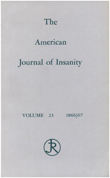Frontal leukotomy and related psychosurgical procedures in the era before antipsychotics (1935-1954): a historical overview
Abstract
OBJECTIVE: This article provides an overview of the history of psychosurgery as a treatment for psychiatric illnesses. METHOD: The author reviewed articles describing psychosurgery between 1935 and 1954 in order to summarize surgical techniques, clinical indications for surgery, patient selection, complications, and outcome. RESULTS: Patients were operated on for a wide variety of psychiatric illnesses. Initially, a large number of uncontrolled studies reported considerable therapeutic benefit in at least one-third of the patients operated on. Complications with the early surgical techniques included hemorrhage, seizures, infection, and personality changes. Surgical techniques proliferated in hopes of achieving greater therapeutic benefit while minimizing detrimental side effects. As psychosurgery became more widely accepted, its principal supporters began to use it as a routine therapy. A number of uncontrolled and controlled short-term studies supported the efficacy of psychosurgery, but long-term controlled studies showed mixed results. CONCLUSIONS: Psychosurgery was promoted as a treatment for patients who had shown little or no response to less drastic therapies. In the context of an era when no efficacious treatments were available for psychosis, its use was understandable. However, its history illustrates the importance of critical evaluation of new treatments in the context of long-term controlled outcome studies, the natural course of specific illnesses, and an understanding of brain physiology.
Access content
To read the fulltext, please use one of the options below to sign in or purchase access.- Personal login
- Institutional Login
- Sign in via OpenAthens
- Register for access
-
Please login/register if you wish to pair your device and check access availability.
Not a subscriber?
PsychiatryOnline subscription options offer access to the DSM-5 library, books, journals, CME, and patient resources. This all-in-one virtual library provides psychiatrists and mental health professionals with key resources for diagnosis, treatment, research, and professional development.
Need more help? PsychiatryOnline Customer Service may be reached by emailing [email protected] or by calling 800-368-5777 (in the U.S.) or 703-907-7322 (outside the U.S.).



